Red vs. Blue: Kerberos Ticket Times, Checksums, and You!

This blog post was co-authored with Charlie Clark of Semperis.
1 Introduction
At SANS Pen Test HackFest 2022, Charlie Clark (@exploitph) and I presented our talk 'I’ve Got a Golden Twinkle in My Eye' whereby we built and demonstrated two tools that assist with more accurate detection of forged tickets being used. Although we demonstrated the tools, we stressed the message of focusing on the technique of decrypting tickets rather than the tools themselves.
As we dove into our research of building IOAs, we often found ourselves examining ticket times and checksums and were repeatedly surprised by the lack of information from both Red and Blue perspectives for the ticket times and the checksums of Kerberos tickets. As such, this post will provide a more in-depth background to explain their importance and how/why understanding them can better serve offensive and defensive operators.
2 Ticket Times
2.1 Background of Ticket Times
In Kerberos, each ticket contains three timestamps. These times govern the period for which the ticket is valid. The three times are:
- Start Time[1] – The time from which the ticket becomes usable
- End Time – Calculated from the Start time and the time the ticket becomes unusable
- Renew Time – Calculated from the Start time and the duration of renewal[2]
Both Blue and Red teams should be especially cognizant of the 'End' and 'Renew' times. The understood limits for these times are stored in the Kerberos Policy within the domain GPO. While it's true that this policy determines the max values for these times, in many situations it is the account configuration and group membership that take a higher priority. It is important to know that the times discussed in the rest of this section define or calculate the maximum value for the relevant time and that a ticket can always be requested for a time before the maximum.
Within the Kerberos Policy there are three settings relevant to ticket times:
- Maximum lifetime for a service ticket – the number of minutes from the Start Time that a service ticket’s End Time can be
- Maximum lifetime for a user ticket – the number of hours from the Start Time that a TGT’s End Time can be
- Maximum lifetime for user ticket renewal – the number of days from the Start Time that a TGT’s Renew Time can be
The following is a screenshot of the default values for these settings:

(The above screenshot is courtesy of Wendy Jiang of Microsoft, answering a question on Microsoft’s forum.)
2.1.1 Ticket Times and the Protected Users Group
In AD domains with at least one 2012+ Windows domain controller, there is a group called Protected Users that provides 'enhanced security' through membership. The Protected Users group has multiple facets; however, the protection relevant to ticket times is that both End and Renew Times have their max values set to four hours, meaning the maximum for both times is the ticket Start Time + four hours. However, looking at the documentation, this is far from clear:

2.1.2 Logon Hours
Within AD, a feature exists to restrict when a user can or cannot log on. This can be configured individually on the user’s properties. The hours can be configured as either permittedor denied.

Each block in this table represents an hour of the day, and this translates to a bit in the logonHoursattribute of that user account.

For tickets to the kadmin/changepw service, the End and Renew Times are two minutes after the Start Time.
2.2 Ticket Times for Blue Teams
To detect a forged ticket, it is imperative for a Blue team to inspect the times associated with the ticket. This can greatly increase the chances of detecting anomalous activity. One of the most well-known IOAs associated with a Golden Ticket is the default End and Renew time of 10 years minus two days. A savvy attacker can easily employ OPSEC to avoid this IOA. However, we can still have great success in catching 'smash and grab' attackers.
An interesting control Blue teams can employ is to create a higher priority policy than the Default Domain Policy and set the Kerberos Policy to non-default. As attackers generally only look at the Default Domain Policy for the times when forging tickets, it is likely many will miss the policy that takes a higher priority. It is important to note that the times need to be set lower and not higher than the Default Domain Policy, as tickets with times lower than the max values are still valid. Below, we have created a new policy and moved it to be the first position in the GPO link order.
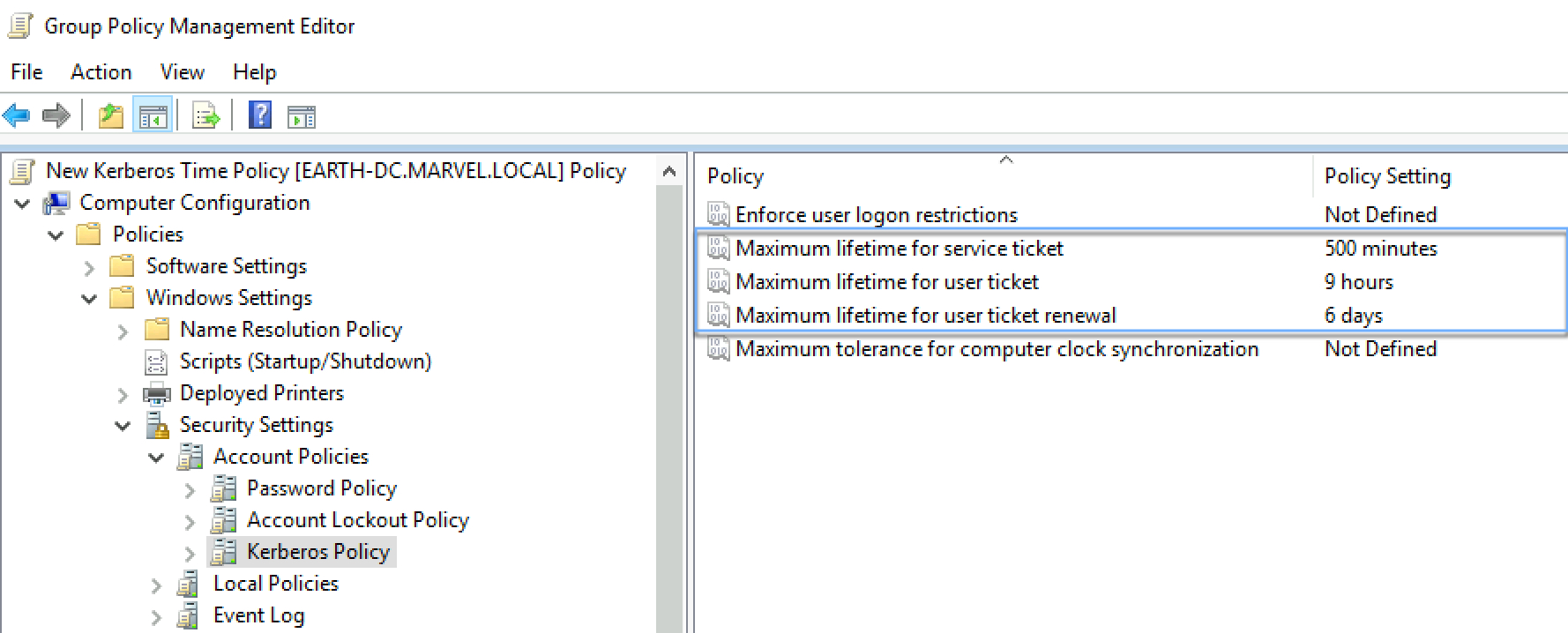

Now, let’s look at our example user ironman and proceed to forge a Golden Ticket. (Note: For this demonstration, OPSEC is not employed.)

Looking at our Golden Ticket for ironman, we can clearly see that the EndTime and RenewTill times are wrong as they are based off the Default Domain Policy and not the 'custom' policy that was prioritized. In contrast, the screenshot below shows a genuine, initial TGT (#1) that has the End Time of nine hours after the Start Time, matching the new custom Kerberos Policy for user tickets, and a delegated TGT (#0) that has the End Time of eight hours and 20 minutes (or 500 minutes), matching the custom Kerberos Policy for service tickets. This also highlights the importance of making the service ticket lifetime different (lower) than the user ticket (TGT) lifetime. Both tickets have the new Renew Time of six days.

Our tool WonkaVison automates most of these checks but does not, at the time of this post, examine the correct order of GPO Policy or their priorities.
Tier-0 accounts with a greater level of privilege in a domain are often high-value targets (HVTs) for attackers. As such, the Blue team can add these users to the Protected Users group for enhanced protection features. Given that users within the Protected Users group have restricted ticket times, the Blue team can use this to detect forged tickets by attackers that do not take this into account. Note: Per the official Microsoft Documentation, service and computer accounts “…should never be members of the Protected Users group”. It is also good security practice to ensure these accounts are not highly privileged.
Additionally, the Blue team can use AD’s feature of restricting logonHoursto their advantage. By enabling, tracking, and alerting, a user attempting to log on during a restricted time can be an IOA of an attacker, as it may be anomalous, using a compromised account.
It is important to note that the restriction of logonHours will not prevent the actual usage of the Golden Ticket. However, it will prevent the ability to request an initial TGT (ASKTGT).

If we check our Windows EVTX logs filtering on Kerberos events (generally EIDs: 4768 and 4769), we get the following event:

Most notably, Ticket Encryption Type (0xFFFFFFFF) translates to This type shows in Audit Failure events, and the Failure Code (0x12) resolves to KDC_ERR_CLIENT_REVOKED. From a deterrence point of view, we can see the benefit of this control. However, from a detection/hunt/DFIR point of view, this event by itself would not have high fidelity in catching an attacker, as it would most likely be prevalent in most organizations. Granted, as the event does have the source IP address in question, the event can be correlated with EID 5156, as shown by Jonathan Johnson’s (@jsecurity101) research.
2.3 Ticket Times for Red Teams
As previously discussed, the Protected Users group provides added security controls to its members to boost IAM. By enumerating its members, an attacker can identify which users are restricted and can then tailor forged tickets to blend in more normally within the restricted operating times, making it harder for defenders to identify anomalous activity.
As noted, the logonHours attribute is in raw bytes and is not easily human readable as a result. An attacker or Red teamer reading this attribute prior to forging a ticket can be extremely beneficial for evading detection when attempting to compromise another (e.g., lateral movement) asset. Charlie Clark’s fork of PowerView automatically converts the logonHours attribute to a more readable form.

As we can see in the above screenshot, the user ironman is restricted from logging on during the hours of 2300 - 0300 on Thursdays. This means that if the domain policy for the End and Renew Times of the ticket is longer than the next time where logon is restricted, then these will become the new End and Renew times.
The Red team should be aware of when a user can log on, because if they use a forged ticket during a user’s restricted hours, the Blue team could use a Windows Event ID 4769 to see if a service ticket was successfully requested. A logon during a restricted time would be anomalous as this would not be possible during normal operations.
Additionally, the Red team can enumerate the Kerberos Domain Policy. This can be performed with a recent commit Charlie Clark made to his fork of PowerView.

Here, not only is the GPO priority shown for the given organizational unit (OU) but also the various statuses of the GPO. This function, however, does not consider inheritance, but for this particular usage, that should not be an issue. By knowing this information, we can then calculate the correct values and pass them to Rubeus manually when forging a ticket.
Note: Charlie Clark also has a function Get-RubeusForgeryArgs within PowerView that automates the calculation of the ticket times. However, for the user ironman, the reason Get-RubeusForgeryArgs has not added the EndTimeand RenewTill arguments is that, at the time of execution, ironman is not allowed to log on as specified by the logonHours. Because ironman is also not a member of the Protected Users group, Get-RubeusForgeryArgs has defaulted back to the Kerberos Policy, and since it only looks at the Default Domain Policy, which is set to defaults, it hasn't added the arguments.
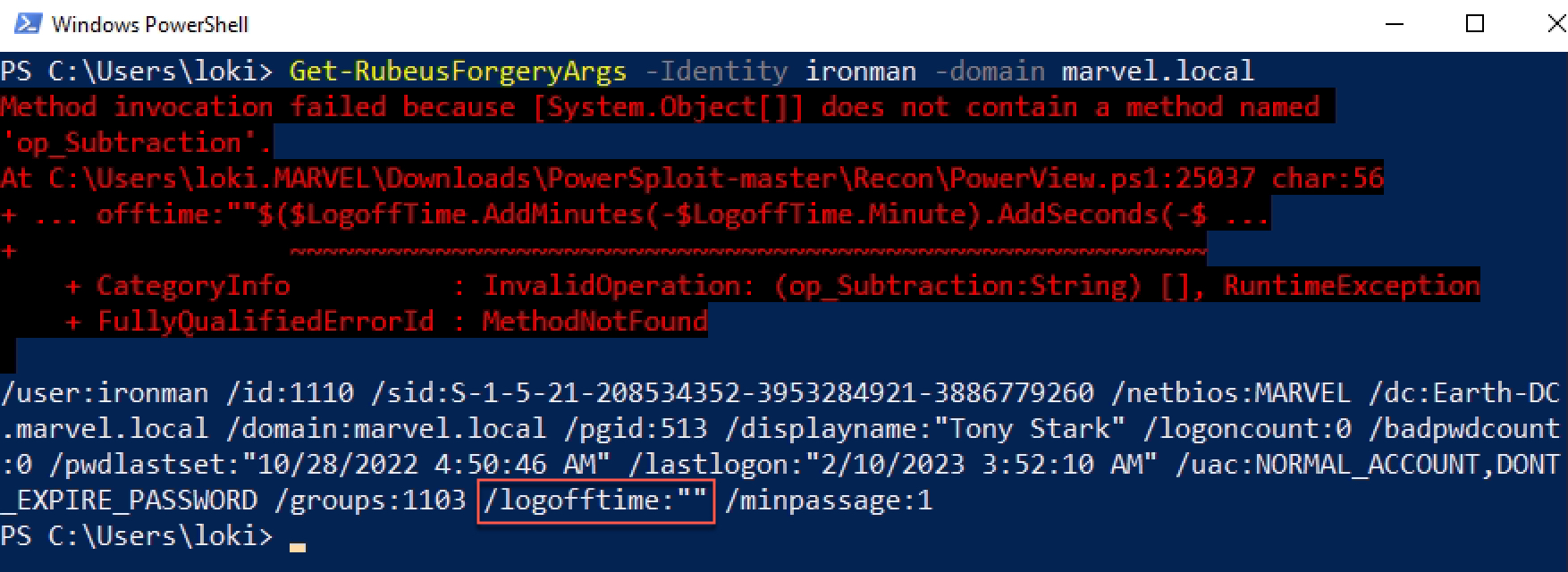
Using Get-RubeusForgeryArgs against a regular user, the script has not taken into account the higher priority GPO Policy that was created above and incorrectly calculates the times to be the defaults, thus leaving the arguments out again.

Get-RubeusForgeryArgs correctly calculates the End and Renew Times for the user thor, a member of the Protected Users group.

3 Checksums
3.1 Background of Checksums
Another key part of the ticket that caught our eye during our research was the Checksums. There are several types of checksums stored in the ticket, depending on the type of ticket. These checksums are there to prevent the ticket from manipulation. One thing to keep in mind for the next sections is that the words Checksum and Signature are used interchangeably.
Originally, there were two checksums (Server and KDC). As a result of the Bronze Bit Attack, Microsoft implemented the Ticket Checksum. More recently, Microsoft implemented the FullPAC Checksum as a result of CVE-2022-37967.
Microsoft’s documentation on PAC_SIGNATURE_DATA, which is the name of the structure within the PAC where a checksum and its type are stored, can be found here.
3.2 Types of Checksums
3.2.1 Server Checksum
The Server Checksum is generated by the KDC and covers the PAC with the Server and KDC Checksum signatures ‘zeroed’ out (each byte of the signature buffer set to zero). The key that is used to encrypt the ticket is also used to create the checksum.
Microsoft’s documentation on the Server Signature can be found here.
3.2.2 KDC Checksum
The KDC Checksum protects the Server Checksum and is signed by the KRBTGT key.
Microsoft’s documentation on the KDC Signature can be found here.
3.2.3 Ticket Checksum
The Ticket Checksum was introduced to protect the encrypted part of the ticket from modification. The Bronze Bit attack took advantage of the fact that, for an S4U2Self ticket, the requesting account could decrypt the ticket, modify the encrypted part, re-encrypt it, and use the ticket. The Ticket Checksum covers the encrypted part of the ticket with the PAC set to 0 (a single byte set to zero).
Microsoft’s documentation on the Ticket Signature can be found here.
3.2.4 FullPAC Checksum
The FullPAC Checksum was introduced to protect the PAC from an RC4 attack. As a result, Microsoft released an OOB patch in the November 2022 patches. As it stands, this signature is in audit mode until October 2023 when Microsoft will begin automatic enforcement of this signature. Interestingly, as of writing this blog post, this signature has not been documented on Microsoft’s website.
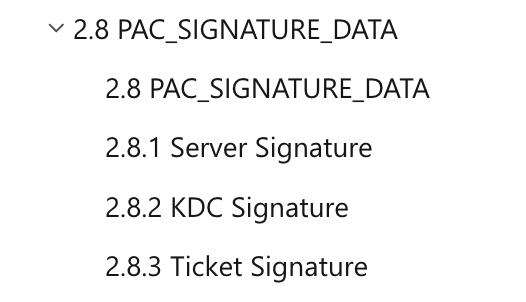
The FullPAC Checksum is essentially the same as the Server Checksum but signed with the KRBTGT key. So, it covers the whole PAC with the Server and KDC Checksums zeroed out.
Note: Ticket and FullPAC Checksums are not present in TGTs or referrals. They are only present in service tickets.
For the next two sections, we are mainly going to focus on service tickets and referrals. The reason for this is that local TGTs are protected by the KRBTGT key and therefore only contain the Server and KDC Checksums, which are both signed with the KRBTGT key. If an attacker can forge a TGT, then they can also sign both checksums correctly. However, this is not the case for service tickets and referrals. While genuine referrals lack the Ticket and FullPAC Checksums, the KDC Checksum is still signed with the KRBTGT key while the trust key is used for the Server Checksum and ticket encryption.
3.3 Checksums for Blue Teams
For the Blue team, having the ability to gain telemetry into the PAC to view the checksums is a significant indicator that a forged ticket has been created and most likely used. To help identify forged tickets via the use of checksums, we have created the 'Charlie Checksum Verification Test'.
In this example, I have supplied the following command to Rubeus to generate a Silver Ticket:
<code>Rubeus.exe silver /aes256:<aes256_key> /ldap /user:thor /service:cifs/asgard-wrkstn.marvel.local /nowrap</code>Our terminal output will show the following, noting that the ServiceKey and the KDCKey are the same.
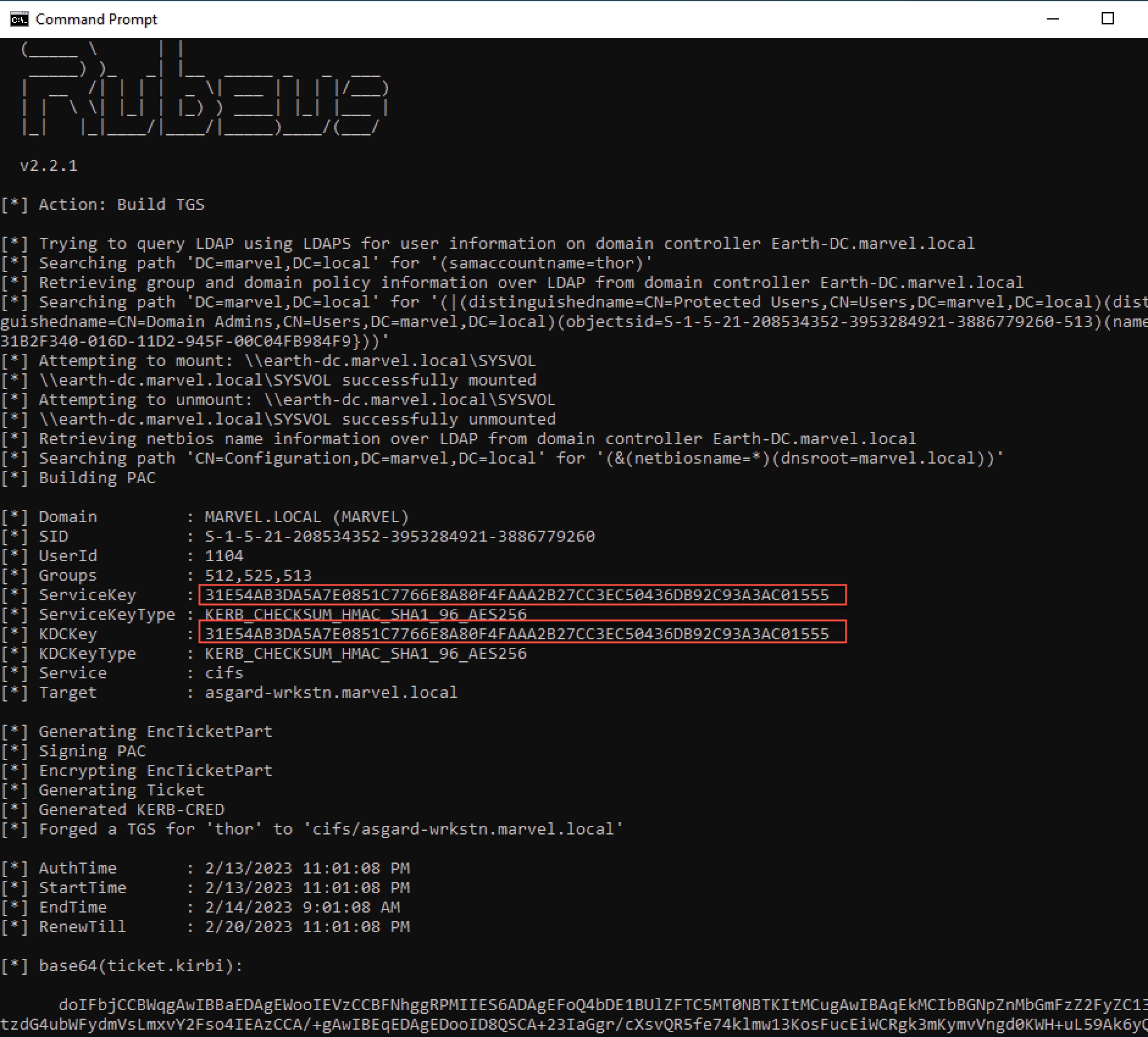
If we describe our Silver Ticket and use the ServiceKey and the actualKRBTGT key via the /krbkeyparameter, we can verify any checksum that has been signed with the KRBTGT key (i.e., the KDC, Ticket, and FullPAC Checksums). We will see in the next screenshot that these checksums are INVALID. This indicates, but does not solidify or confirm, that the service ticket is forged. The exception being that the KRBTGT key may have been rotated since the creation of the service ticket, further checks would be required to determine this.
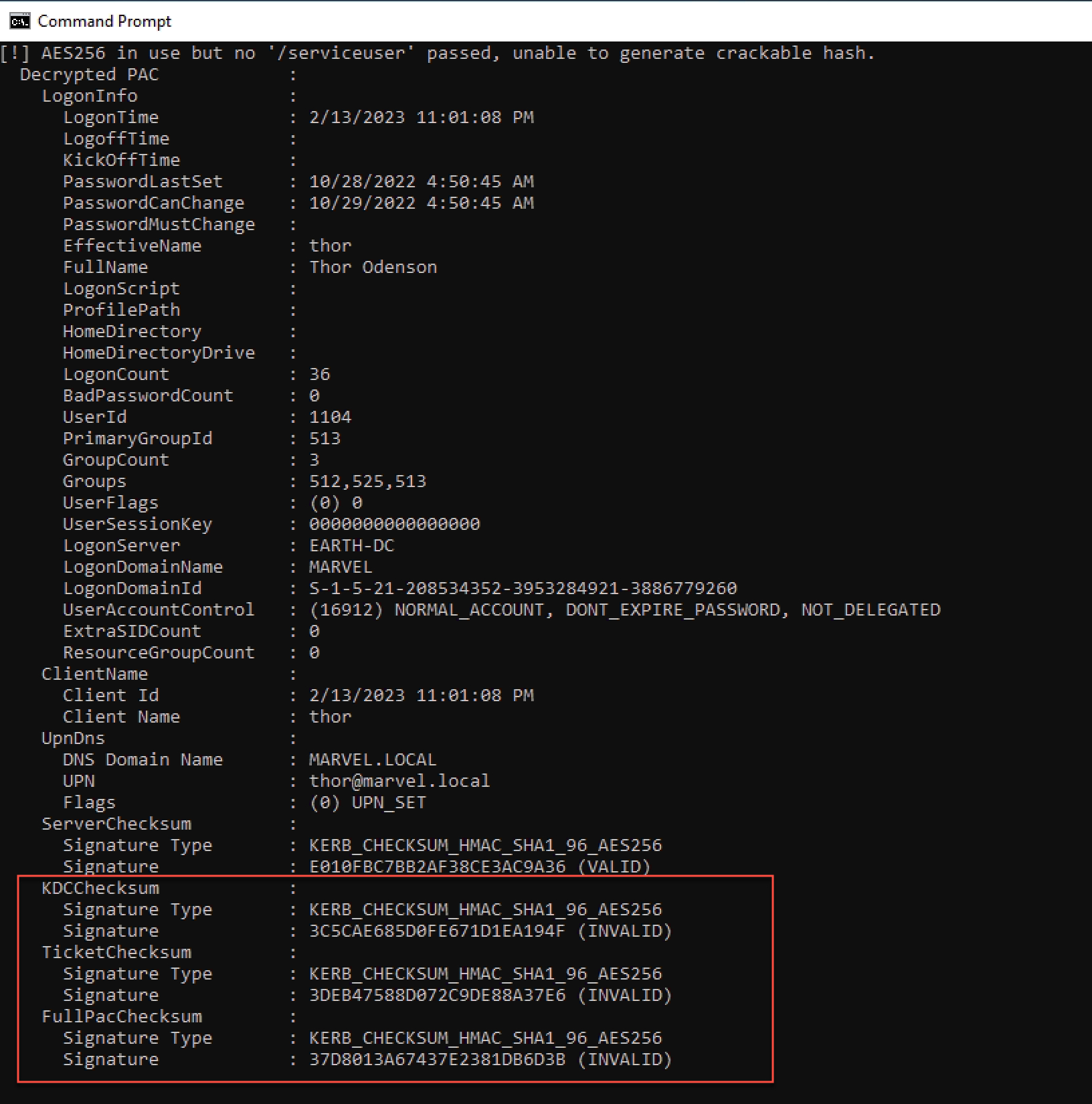
It would be better for the Blue team to first check with the ServiceKey as the/krbkey. If that matches, then you have a forged ticket!
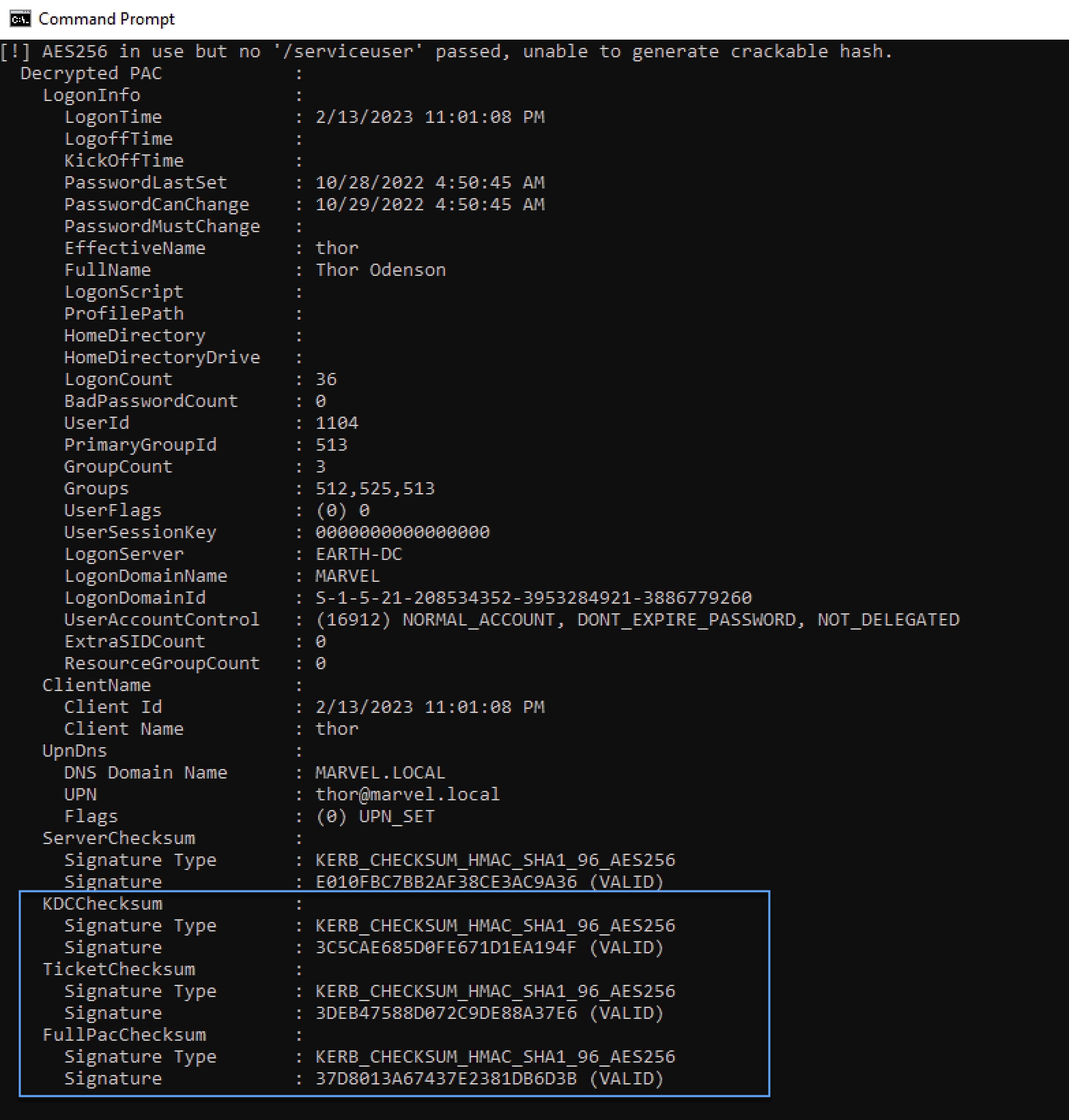
3.4 Checksums for Red Teams
All four checksums have been implemented into Rubeus, with the last being merged with this PR. However, this is currently not the case with the main branches of Mimikatz and Impacket.
Part of the Red team’s greatest weapon in their arsenal is the employment of OPSEC. The more similar a forged ticket is to a genuine ticket, the more difficult it is to detect.
The advantage of using Rubeusfor Silver Ticket creation is the ability to pass the /krbkey, which will then be used to sign any checksum that is normally signed by the KRBTGT key. To best avoid detection, a Red teamer should use the real KRBTGT key. However, if one does not have the real KRBTGT key, a false one can be easily passed to Rubeus, which has a higher likelihood of avoiding detection than using the ServiceKey.
4 Conclusion
Our main purpose of this post, while this information is not 'new' or 'revolutionary', is to show how an intimate understanding of normal operations can help both Blue and Red teams in detection and OPSEC, respectively.
While gaining access to the encrypted part of Kerberos tickets may be a challenge for Blue teams, the importance of doing so for detection cannot be emphasized more. However, while it is not possible to review the checksums without decrypting the tickets, the ticket times are more easily accessible through commands like klist or the underlying call to LSA that klist makes use of.
For Red teams, the ability to blend in with normal operations is a high priority. While it may not be possible to completely emulate normal behavior, such as using a Silver Ticket when the KRBTGT key is not available, understanding what Blue teams may look for to definitively determine malicious activity will always be beneficial.
Ultimately, all of us are working to improve security in a positive way, and that happens best when everyone has more information about how everything works.
5 Acknowledgements
A special thank you to the following individuals for helping review this post:
Elad Shamir (@elad_shamir)
Carlos Perez (@Carlos_Perez)
Julie Daymut
Megan Nielsen (@mega_spl0it)
Roza Maille
Jessica Sheneman
[1]. Technically, there is also Auth Time. Most often, Start Time and Auth Time are the same. For simplicity, we will not focus on Auth Time. If there is an Auth Time that is vastly different from the Start Time, the ticket will likely be issued for the future, in which case the Start Time of the ticket is the time from which when the End and Renew Times are calculated.
[2]. Keep in mind the ticket must be renewed before the End Time.